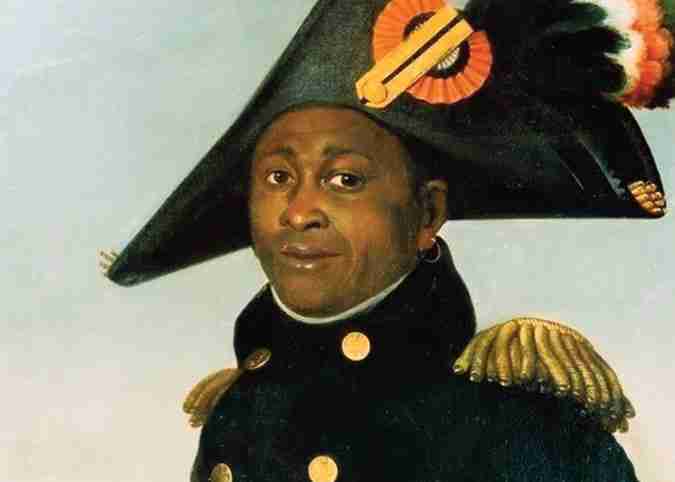Posthumous 1813 painting of Toussaint L’Over ture. PHOTO COURTESY OF WIKIPEDIA.ORG
One of the most racist diatribes I ever heard came from a Black woman. She was from my hometown in North Florida but lived in Miami and I happened to encounter her on one of her visits home. The target of her ire: her Haitian coworkers. I was in high school and didn’t personally know anyone from Haiti, or anything about the nation, but even at that young age, her ranting struck me as ignorant, mean-spirited, and ridiculous.
Fast forward a few years to my time at Florida A&M University, where I began to be exposed to the breadth and beauty of the history of people of African descent. Learning about the Trans-Atlantic Slave Trade expanded my understanding of enslavement and chattel slavery beyond the borders of what would become the United States. In fact, of all the sites of slavery in the so-called New World, North America received the least number of enslaved people, an estimated 500,000 during the era. Infinitely more, an estimated 6 million, ended up in the Caribbean scattered between the colonial holdings of the Spanish, British, French, and Portuguese.
How could all of those tiny islands consume so many Black people? The horrible reality is that the life expectancy of those unfortunate enough to be sold in the Caribbean was about 7 years. This was particularly true of the French colonies which produced sugar like Saint Domingue, now known as Haiti.
The enslaved people on that island would make history in the Western Hemisphere. After years of exploitation and brutality, the enslaved men and women on the island instigated a rebellion famously sparked by the maroon leader Boukman beginning in 1791. After years of bloody struggle, led by military leaders like Toussaint L’Overture and Jean-Jacques Dessalines, the conflict culminated with their victory over their French colonial masters and the British forces sent to assist them. In the process of establishing their own government, Dessalines famously removed the white stripe from a French flag, representing a rejection of white colonial rule. In a direct reference to the rhetoric famously used by Patrick Henry during the American Revolution, he also ordered that the phrase “Liberte ou la Mort” (“Liberty or Death”) be inscribed on the flag. The Congress of Arcahaie adopted the flag as the banner for the new nation they were forming on May 18, 1803. Catherine Flon was given the task of stitching the remaining blue and red remnants together. On January 1, 1804, the banner became the flag of the nation of Haiti, which became the second independent republic in the hemisphere after the United States, culminating in the most successful slave rebellion in the hemisphere.
The irony still resonates. Despite the ignorant rant that introduced Haiti to my consciousness, the people of Haiti had in fact been at the tip of the spear that would eventually end slavery in the entire hemisphere. The economic and political disruption of the Haitian Revolution and the accomplishment of Haitian independence resulted first in the expansion of the United States with the Louisiana Purchase, but also served as inspiration for enslaved Blacks throughout the nation. American slaveowners took steps to prevent the revolutionary fervor from reaching their shores, even going so far as to ban the importation of Blacks who had been enslaved in Haiti.
Slave rebellion was the perennial fear among slaveholders and Haiti was the foremost example of their worst nightmare. For enslaved Black Americans, Haiti stood as a source of inspiration. Speaking in 1893, Frederick Douglass reminded his audience that “When [the Haitian revolutionaries] struck for freedom, they builded better than they knew. Their swords were not drawn and could not be drawn simply for themselves alone. They were linked and interlinked with their race, and striking for their freedom, they struck for the freedom of every black man in the world.”
The example of Haiti disrupted the goals and aims of extractive racial capitalism and slavery. It fostered hopes of freedom in enslaved and oppressed people throughout the hemisphere, from the U.S. to Venezuela. Haiti was a cautionary tale for U.S. politicians, whose fight over how to loose the wolf they held by the ears led to a war that eventually brought emancipation to Blacks enslaved in the United States 62 years after Haitian independence.
The observation of Haitian Flag Day on May 18 and Florida’s Emancipation Day on May 20 are important and parallel traditions that preserve the legacies of two separate but parallel struggles for liberty and freedom. More importantly, the pair of holidays offer an opportunity to learn about and share the history and culture of Black Americans and Haitian Americans. Both liberation stories are sources of inspiration, pride, and hope.
Tameka Bradley Hobbs, Ph.D. is the regional manager of Broward County’s African American Research Library and Cultural Center in Fort Lauderdale, Fla., and serves as project director for the “The 20th of May: The History and Heritage of Florida’s Emancipation Day” Digital History Project, funded by Florida Humanities. Visit the portal at www.FloridaEmancipationMay20.com.









No Comment